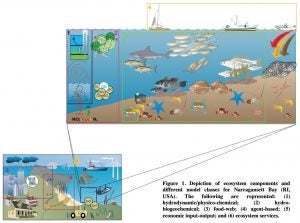Developing a coupled social-ecological ecosystem model of Narragansett Bay fisheries using Ecopath
 Principal Investigator: Annie Innes-Gold (URI CELS), Maggie Heinichen (URI GSO), and K. Gorospe (URI CELS)
Principal Investigator: Annie Innes-Gold (URI CELS), Maggie Heinichen (URI GSO), and K. Gorospe (URI CELS)
Collaborators: Austin Humphries (URI CELS/GSO), Jeremy Collie (URI GSO), Conor McManus (RI DEM), Jason McNamee (RI DEM)
Funding Source: RI C-AIM (EPSCoR)
Ecological modelling is a powerful tool to explore relationships among species and ecosystem components. As the environmental conditions and external drivers change in the Bay, such as fluctuations in temperature, nutrients, and fishing pressure, there is a need to have an idea of how this will affect higher trophic species including those of commercial and recreational importance. This project looks to create an integrated ecosystem model linking the environmental, ecological, and human dimensions of Narragansett Bay. First, a qualitative model of these systems will examine the main components of each subsystem and explore the general relationships between them. The program Ecopath with Ecosim (EwE) translates this qualitative work into a quantitative model, exploring energy flow within the system and can be used to run temporally dynamic simulations.
The first phase of this project is to assemble the best data available for the model inputs, including biomass, production, consumption, and diet composition for species of ecological or commercial importance. The EwE model will be validated using historical fisheries catch and biomass data, and then used to predict how the ecosystem balance will change under different scenarios of environmental change. Finally, it will be coupled with further socio-cultural and environmental models to expand the scope of potential management applications. Our goal is to better understand and predict how environmental fluctuations and fisheries management policies will impact the Narragansett Bay foodweb.
 Home
Home Browse
Browse Close
Close Events
Events Maps
Maps Email
Email Brightspace
Brightspace eCampus
eCampus


